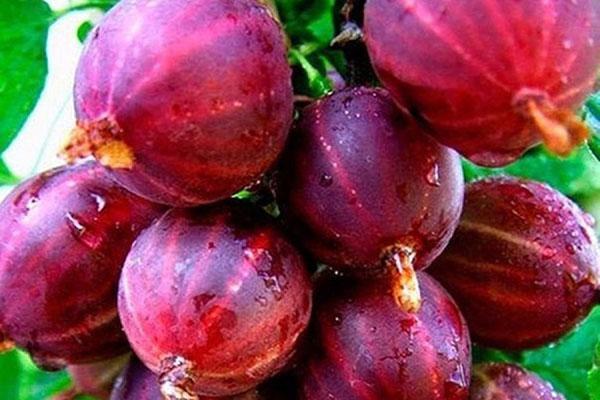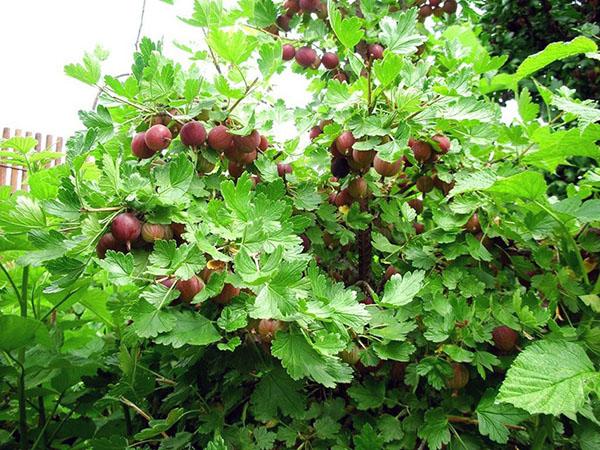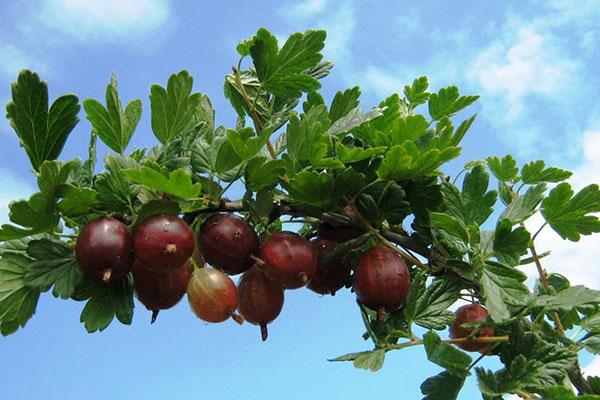Gooseberry variety Kolobok: a find for a gardener
 A medium-sized shrub with pubescent berries and many thorns. But the new gooseberry variety Kolobok is absolutely devoid of thorns. Juicy aromatic berries contain a whole bunch of vitamins, trace elements, free acids and pectin substances.
A medium-sized shrub with pubescent berries and many thorns. But the new gooseberry variety Kolobok is absolutely devoid of thorns. Juicy aromatic berries contain a whole bunch of vitamins, trace elements, free acids and pectin substances.
Due to the high content of the latter, excellent preparations are obtained from the fruits: jelly, confiture, marmalade and jam... In addition, the use of berries is recommended for obesity and metabolic disorders.
Gooseberry variety Kolobok - botanical description

The following characteristics can be added to the description of the gooseberry Kolobok:
- the height of the bush is 1-1.3 m;
- frost resistance - up to -25 degrees;
- yield - from 4 to 7-8 kg, depending on agricultural technology;
- good transportability;
- taste - 4.5 points;
- berry picking is carried out almost all summer - from late June to late August.
Moreover, they practically do not crumble and do not choke in the hands.
The gooseberry bush of the Kolobok variety is densely leafy, spreading. Therefore, regular pruning is required. Otherwise, unproductive thinned shoots of the 2nd, 3rd, 4th order will appear. The bulk of the crop is on biennial branches. In inflorescences of the Kolobok gooseberry variety, there are often two flowers, of which, respectively, two berries are formed.
The bushes react negatively to the change of frost and thaw, but recovery is quick.
Differs in stable anthracnose resistance and powdery mildew, unlike other varieties.
Gooseberry Kolobok - planting and care
 You can plant a plant in the ground both in spring and autumn, but the second option is preferable, since spring plantings may not have time to get stronger before the onset of hot and dry days.
You can plant a plant in the ground both in spring and autumn, but the second option is preferable, since spring plantings may not have time to get stronger before the onset of hot and dry days.
Landing
 If you have to plant in the spring, then they do it as soon as the soil allows (early April), while the planting pit is being prepared in the fall. The roots are treated with a biostimulant (Kornevin, Epin, etc.), and the branches are shortened, leaving no more than 4 buds.
If you have to plant in the spring, then they do it as soon as the soil allows (early April), while the planting pit is being prepared in the fall. The roots are treated with a biostimulant (Kornevin, Epin, etc.), and the branches are shortened, leaving no more than 4 buds.
In the spring, the Kolobok is placed in the pit at an angle of 45 ° for the fastest growing of the root mass. This does not apply to autumn planting.
The best time for this event is 2-3 weeks before frost, so that the seedling has time to take root and grow.
Gooseberries love sunny places without stagnant water, light soils (sandy loam or loam) with an acidity of 5.5. Before planting the bushes, the entire area is dug to the depth of the shovel bayonet, while picking out the roots of the weeds and applying a complex mineral fertilizer, for example, nitrophoska (2 tbsp. L. Per sq. M.). Then they are leveled with a rake.
Planting pits with a depth of 0.5 m are located at a distance of 1.5-1.7 m from each other. They include:
- humus - 1-1.5 buckets;
- superphosphate - 170 g;
- potassium - 50 g.
Wood ash can be added. Stir everything with a shovel and pour 1-2 buckets of water. Gooseberries are planted without burying the root collar. Then they make out the trunk circle with an earthen roller, pour another bucket of water and mulch with humus.
Sawdust is not used, because in spring they thaw for a long time, and fresh ones also increase the acidity of the soil.
At the right time, the planted gooseberry will tolerate the winter well, and in early spring it will start to grow.
Care
 If the principles of planting do not differ from the technique of planting gooseberries in general, then caring for the Kolobok is somewhat different. Since the variety is prone to thickening, more careful and regular pruning is required.
If the principles of planting do not differ from the technique of planting gooseberries in general, then caring for the Kolobok is somewhat different. Since the variety is prone to thickening, more careful and regular pruning is required.
It can be carried out both in early spring and in autumn. Since the shape of the bush is spreading, it is pruned to a bud growing inside the bush (oriented upward):
- In the first year, the branches are shortened by ½ the length.
- In the second year, when more than 7-8 shoots are formed, the extra ones are cut out, the remaining ones are shortened by a third.
- In the third year, all weak shoots growing crosswise or in the wrong direction will be removed. Branches of the 2nd order, if possible, are preserved completely, and those that grow vertically are slightly shortened.
- By the 4th year, the plant is fully formed and pruning is aimed at removing weak, sick, frozen, etc. shoots.
 Every year, everything that thickens the crown should be removed, the shoots of the first year are cut to 5-6 buds. Thus, an adult plant has 20-25 different-aged shoots. At the same time, the old ones are removed annually, leaving new replacement shoots to replace.
Every year, everything that thickens the crown should be removed, the shoots of the first year are cut to 5-6 buds. Thus, an adult plant has 20-25 different-aged shoots. At the same time, the old ones are removed annually, leaving new replacement shoots to replace.
For the rest, caring for Kolobok is no different from agricultural technology of other varieties. It consists in timely watering, fertilizing, removing weeds, loosening, mulching, treatments for diseases and pests. Moreover, watering is carried out only in very dry weather, since gooseberries are an unpretentious plant.